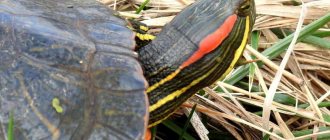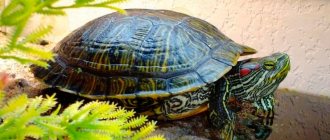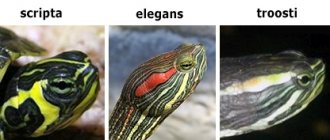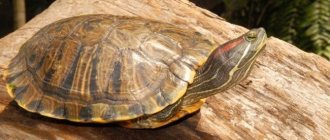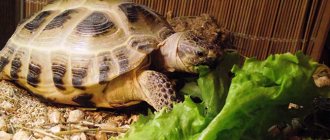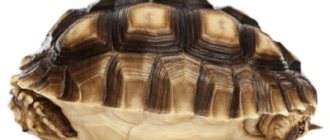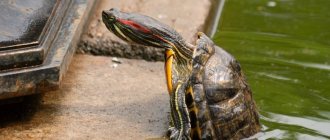Red-eared (yellow-bellied) turtles are freshwater reptiles. Their natural distribution range is: the United States of America, Southeast Asia, South Africa and Central Europe. The first mention of them dates back to the middle of the sixteenth century. Today, this type of turtle is almost the most popular of all those that populate aquariums and terrariums at home. But, if you decide to purchase this animal, you need to carefully study all the rules regarding its maintenance and care, since even the slightest non-compliance with them leads to the development of various diseases and even the death of the pet. If red-eared turtles are properly cared for, they will become quite hardy and unpretentious inhabitants of aquariums in which they spend most of their lives.
Description of the red-eared turtle
The yellow-bellied turtle received this name due to the presence of red stripes running from the eyes to the ears. Because of this unique feature, the red-eared turtle can be easily distinguished from other species of turtles kept in human environments.
Interesting to know! In conditions favorable for their habitat, red-eared turtles can live for at least 25 years. At the same time, there are individuals that live up to 50 years.
In young individuals, the shell is bright green, but as the turtle grows and develops, this shade becomes brown. In adults, original patterns can be seen on the shell, and each turtle may have a unique pattern. The size of a turtle directly depends on its gender and can range from 18 to 30 cm. Oddly enough, females are larger than males.
Natural enemies
Thanks to its thick shell and relatively large size, the red-eared turtle faces few threats, with the exception of alligators and crocodiles. Plus, they quickly slide into the water at the slightest sign of a threat from the shore.
But there are a lot of predators hunting for young turtles:
- foxes,
- skunks,
- raccoons,
- various wading birds.
Mammals on this list also dig up their eggs. In general, in their natural habitats, red-eared turtles are an important element of the food chain, both as prey and as a predator. And in urban reservoirs they become a source of food mainly for stray dogs and cats.
Young turtles have an interesting type of defense against being eaten by fish. If a fish swallows them, they begin to chew the mucous membrane from the inside until the fish spits them out. The turtles are brightly colored, and the fish quickly remember that they cannot be eaten.
Recommendations for purchasing a red-eared slider
Spring is the most suitable period for purchasing a pet. In warm weather, it is much easier for an animal to adapt to new living conditions, especially since in warm weather there is much more natural food. If you purchase a turtle in the fall, then in such conditions the turtle’s growth slows down and it is more difficult for it to adapt to new conditions. In addition, during this period there is a risk of developing rickets or pneumonia due to vitamin deficiency.
First of all, you need to carefully examine the shell. It must have the correct shape and be free from scratches, deformations and other damage. At the same time, it must be hard, which will indicate proper nutrition of the animal and its proper development. The leather should also not have cracks or any stains. If an animal has sunken eyes surrounded by a small “recess,” this means that the animal is sick and suffers from dehydration. The turtle's eyes should not be swollen, much less discharge. Her mouth should also be healthy, without white coating, abrasions or wounds. In this case, you should pay attention to the behavior of the little turtle. If the animal is lethargic, then something is wrong with it.
Interesting fact! A strange formation can be seen on the plastron of a young turtle. In fact, these are the remains of the gall sac, which supplies nutrients to the small creature. This alarming formation soon resolves on its own. After this, the animal begins to feed on its own and is quite active.
It is very important to learn how to determine the sex of red-eared turtles yourself, while small individuals look exactly the same, regardless of gender. As they grow older, sexual characteristics begin to fully appear. Males mature somewhat faster than females and are ready to mate when the carapace diameter is 10-12 cm, but females are still large. Males have much longer claws located on their front paws and they also have a thicker and longer tail. The male's cloaca is located almost in the center of the tail.
Care and maintenance of red-eared turtles!
Popular types
These turtles have three subspecies:
- red-eared or Florida,
- Cumberland or Trust's tortoise,
- yellow-bellied slider.
Red-eared or Florida (trachemys scripta elegans)
The shell of the Florida red-eared slider reaches 280 mm. The photo clearly shows its wide postorbital stripes and narrow stripes on the chin - red, which gave the name to the whole species. Each carapace plate has a transverse yellow stripe, and the plastron plate has a large dark spot. The subspecies is found mainly in the western and central regions of its natural habitat.
Cumberland or Troost's turtle (trachemys scripta troostii)
Trust's turtle is the smallest subspecies. It does not exceed 21 cm in length. The narrow postorbital stripes and the wide stripe on the chin are yellow. Each of the carapace plates has a yellow transverse stripe. The plastron scutes are decorated with “eyes” or small dark spots. This subformation has the smallest area of occupation, which is located in the upper Cumberland and Tennessee.
Yellow-bellied slider (trachemys scripta scripta)
The length of the carapace of the yellow-bellied slider reaches 27 cm. Its postorbital spots are yellow and connect to a stripe on the neck. There is also a yellow stripe on each carapace scute. There are dark spots on the anterior scutes of the plastron. This subspecies inhabits mainly the eastern part of its natural habitat.
Features of aquarium (aquaterrarium) arrangement
A container for keeping red-eared turtles is more accurately called an aquaterrarium, and a number of requirements are imposed on such a container. A turtle is a freshwater animal, so there must be a sufficient amount of water in the aquaterrarium. The water should be clean and warm, with a temperature of 22 to 28 degrees. The volume of the turtle house is at least 200 liters.
It is imperative to purchase a special water heater, an ultraviolet lamp, a thermometer, a heating lamp, a filtration system and a lighting system. In the aquaterrarium, a small island should be provided that smoothly turns into water. The area of this island is at least ¼ of the total area of the turtle’s home. The island is not formed on the basis of soil or gravel.
A home for a red-eared turtle is an environmentally friendly space that does not have toxic components and is absolutely safe for animals without the presence of sharp objects.
Interesting Facts
- Red-eared turtles are fast, powerful and very aggressive animals.
- In the wild, it is not difficult for them to attack other turtles and other animals available to them.
- Even among themselves, they often start fights, especially when it comes to food. They put many related species at risk of extinction. Therefore, in some countries, for example, in Australia, they are mercilessly destroyed. Although, apparently, this is not quite the correct approach to solving this issue.
Turtle diet
When kept at home, the red-eared turtle should receive low-fat, preferably river fish. Turtles should be given raw beef liver once for a couple of weeks. In addition, snails, crickets, feed cockroaches, earthworms, and also small aquarium fish should be included in the diet. Food items of plant origin should consist of aquarium vegetation, lettuce, dandelion leaves and plantain.
Interesting to know! Red-eared turtles feed in a peculiar way. They do not secrete saliva, so they only chew food under water.
The aquaterrarium must contain Vitakraft Sepia mineral stone. Many owners of such animals practice feeding their pets with factory diets, such as Tetra ReptoMin, Sera and JBL. The most preferred food that should be given to turtles at least once a month is carrots. Until they reach the age of one year, reptiles are fed every day, and then no more than once every two or three days.
Feeding red-eared turtles! 10 answers to the most popular questions
Compatibility
Turtles and aquarium fish live together, but this is an exception to the rule. Yes, while red-eared turtles are small, they cannot yet swallow neighbors of comparable size to them. Therefore, they can be kept in an aquarium with some predatory fish, such as cichlids. But, firstly, they need quite specific conditions for heating, irradiation and the presence of an island. Secondly, they grow very quickly and are active predators. If they don’t immediately eat the fish, they will constantly swim with their fins bitten off. For the same reason, it is not recommended to combine red-eared turtles in the same aquarium with amphibians - axolotls, newts, frogs - they also will not last long.
So the best option for keeping red whales is a species-specific aquaterrarium. But several turtles can only be kept together if they have enough space both now and in the near future. And even in this case, keeping turtles of different sizes in the same area is not recommended. This is dangerous, as is the case with aquarium fish. The predatory instincts of turtles extend even to members of their own species.
Caring for a red-eared slider
Although turtles are easy-to-keep animals, they still require specific care. The presence of clean water is a guarantee of the health of growing young animals and a guarantee of their active growth. Food that gets into the water begins to decompose and the water takes on a dirty, cloudy appearance, indicating that it is time to change the water. To fill the aquaterrarium, it is necessary to use water that settles for a week (at least 5 days). It is very important to maintain optimal temperature conditions. To do this, you can use a regular incandescent lamp aimed at the island. If necessary, the water is heated by a special heater. Here, a lot depends on the temperature in a person’s home.
It is important to know! Many people believe that if pets are kept in cramped conditions, they do not grow and always remain the same small. Unfortunately, this is a misconception that can lead to the death of the turtle.
Some time passes and the turtle begins to eat on land, which simplifies this process and also reduces the degree of water pollution. It is desirable that the island for resting and eating has not a simple, but a rough surface, then the turtle will be able to get to land without much effort. Individuals that differ noticeably in size should not be kept within the same aquaterrarium.
Many people think that red-eared turtles are slow and clumsy. In fact, they are capable of showing miracles of activity, both in water and on land. Therefore, it is very important that the height of the walls of their home does not allow them to get out. As a rule, the minimum height of the walls should be within 40 cm and not lower. If a turtle accidentally leaves the aquaterrarium, it can receive very serious injuries by falling from a height. As a result, the pet may die, not only from injury, but also from dehydration.
Hibernation
Hibernation is the period that a turtle enters during the winter months. There is no need for a pet turtle to hibernate! Moreover, it is not recommended! Never encourage her to do this.
Reasons why hibernation may be unsafe:
- you may not have enough experience to care for her at this time
- Most likely, in order for her to hibernate normally, you don’t have the conditions
- young and sick turtles may be too weak to survive the hibernation period
- your turtle may not need it at all
Turtles hibernating in nature burrow into leaves and silt at the bottom of a reservoir, the depth of which is shallow, and vice versa into the surface.
They do not rise to the surface during this time, but absorb oxygen through membranes in the mouth, pharynx and cloaca. In this case, the depth of the reservoir is important so that the water is not too cold, but also contains enough oxygen.
Most artificial conditions and ponds are unable to recreate these conditions.
In general, a pet turtle should not and should not be hibernated. By the way, the key condition here is the water temperature, it must be maintained at 24-26°C. Lower temperatures just remind her of winter and hibernation.
Health, disease and prevention
As a rule, most pets, including the red-eared turtle, get sick in most cases due to improper care and maintenance. Dirty and untreated water quickly leads to the fact that the turtle begins to feel unwell, as many harmful microorganisms appear in it. In this case, it is necessary to raise the temperature in her home by a couple of degrees in order to optimize the functioning of the immune system. It is also necessary to ensure that the animal does not experience a lack of moisture (water), otherwise, against this background, kidney failure begins to develop, leading to disastrous consequences.
The fact that something is wrong with the turtle may be indicated by its behavior. When it swims, it can fall on its side or even sink to the bottom. If there is a suspicion of infection, then it is advisable to treat all items for caring for the reptile with an antiseptic that will not cause harm to the animal. Symptoms of bacterial damage are associated with the appearance of edema and necrotic changes. Such diseases require the use of antibiotics for treatment. In this case, you will have to completely replace the water in the aquaterrarium.
If a turtle is injured, an infection can enter its body, leading to blood poisoning. As a result, the animal’s paws turn red, and the turtle becomes quite lethargic and inactive. This type of disease is practically not curable, especially on its own, so you will have to visit qualified specialists. If treatment for your pet is not started in a timely manner, the outcome can be very disastrous.
To prevent this from happening, it is necessary to take preventive measures, such as:
- Inspect your turtle daily.
- Clean the aquaterrarium regularly.
- Change the water regularly.
- Organize proper healthy nutrition.
- Avoid hypothermia.
- Monitor the operation of the heating, lighting and filtration systems.
- Observe personal hygiene rules.
- From time to time, clean the turtle's shell of algae.
- Adhere to the rules for keeping sick or newly purchased animals (quarantine regime).
- Avoid contact of a sick animal with both family members and pets.
- Constantly monitor the turtle's movements outside its home.
- Periodically turn on the UV lamp and expose it to sunlight.
- From time to time, show the animal to a veterinarian.
In case of improper nutrition, the turtle begins to experience a lack of calcium, which leads to curvature and softening of the shell. If there is too much calcium deficiency, your pet may die. In such cases, the veterinarian prescribes drugs with a high calcium content in injections. It is also necessary to know that calcium is absorbed due to the presence of vitamin D in the animal’s body. Vitamin D is produced as a result of UV exposure, so it is very important to regularly turn on the UV lamp.
Pond slider. House maintenance. Interesting Facts.
Handling babies
When a small turtle appears in an aquarium, it should be surrounded with maximum care and attention. If you don't pay attention to a delicate creature, it can die . There are several recommendations on how to care for a small red-eared turtle:
- It is not recommended to pick up babies. Stressful situations for them can result in illness and death.
- Do not stand over the aquarium or knock on its glass.
- The aquarium should not be left in direct sunlight or in a draft.
- The water temperature for babies should be 26-27 °C, the air temperature - 32 °C.
- The water needs to be changed every two days.
- It is necessary to saturate the turtle’s body with calcium.
- Children and adults cannot be kept together.
It must be remembered that many possible health problems in red-eared sliders can be avoided. If you follow the recommendations, this beautiful creature will delight its owner for decades .
Reproduction at home
When turtles live in their natural environment, they begin to reproduce only after reaching 6-8 years of age. When turtles are kept in an artificial environment, they are ready to reproduce at a maximum of 5 years of age. Under natural conditions, the reproduction process begins at the end of February and lasts until May. Having met a female, the male tries to position himself as close to the female’s head as possible.
Important point! At this time, the female moves forward, and the male moves in the opposite direction, while he tries to tickle the female’s chin with his long claws.
When the time comes to lay eggs, the female leaves the pond and heads to land, where she begins to search for a suitable place. After this, she wets the soil with water, which she prudently stored in the anal bladders. Then the female begins to form a nest.
To do this, she uses her hind legs. As a result of the active actions of the turtle, a ball-shaped nest is formed, the diameter of which, depending on the type of turtle, can reach up to 7-25 cm.
The female lays from five to twenty eggs at a time, the diameter of which is up to 4 cm on average. After this process, the turtle covers them with soil. Turtles do not care about their future offspring and immediately climb back into the sea (into the water). Eggs develop at temperatures from +21 to +30 degrees for 3-5 months. When the development of eggs occurs at a temperature of +27 degrees and below, then males are born, and when at a temperature of about +30 degrees and above, females are born.
A crowd of red-eared turtles!
Habitat
Red-eared turtles are found in the area from southern Virginia to northern Florida and Kansas, Oklahoma and New Mexico in the west (USA), Mexico, all of Central America, northwestern South America (northern Colombia and Venezuela). The species is introduced to the south of Florida, Arizona, Guadeloupe, Israel and South Africa and a number of other countries. Turtles live in small lakes and ponds with low, swampy shores.
Nursing turtles
After the clutch is laid, the owner needs to transfer it to a special incubator. It could even be a simple three-liter jar of sand. The main thing is to carefully lower the eggs into it and place it in a warm place, for example, near a radiator. The main thing is that the temperature should always be constantly at +25…+30 °C.
Embryos develop in the egg for two to five months. It all depends on the temperature. If it is high, then the rate of turtle maturation increases, but only girls are born.
Males mature at low temperatures and take much longer.
After the babies hatch from the eggs, under no circumstances should they be transplanted into the aquaterrarium with adults in order to avoid cannibalism. They should be grown in a separate tank for at least a year.
Mr. Tail recommends: feeding
Red-eared turtles are omnivorous and voracious. Protein can be provided in their diet by using the following foods:
- Bloodworms - both frozen and fresh. Just rinse it thoroughly with running water.
- Raw meat - it must be washed and cut into small pieces. Beef, veal, and poultry are suitable. Fat and pork should be excluded. This product can also be used boiled.
- Sea fish - it should be given with bones (an additional source of calcium). The esophagus of turtles is designed in such a way that they simply cannot choke. You should not feed varieties that are too fatty, such as cod or capelin.
- Other seafood.
- Gammarus, snails, river crustaceans.
- Ready-made granulated food for turtles, for example, from Beaphar, Terraworld, Turtles.
But the diet needs to be diversified with plant foods, especially as pets get older. This can be algae, aquatic plants, cabbage leaves, lettuce, pieces of carrots, apples, and other fruits and vegetables.
Ready-made granulated food for turtles should be provided regularly, not only for the purpose of replenishing protein food, because it also contains all the necessary vitamins, micro- and macroelements.
As for the frequency of feeding, it depends on many parameters - age, size, activity of the pets.
Up to a year, all individuals should be fed daily, giving preference to ready-made and protein foods, adding vegetables and fruits once a week.
Adults can be fed every other day or two, but plant food can be given every day. In the diet of turtles, especially recently hatched ones, the amount of protein food should make up more than half of the diet, so meat, bloodworms or gammarus must be added to the granulated food. You can also give small live fish such as guppies or crushed earthworms.
Adults are given ready-made food no more than a quarter of the diet, giving preference to vegetables and fruits.
It is not necessary to finely chop foods for adult pets. Red-eared turtles have very sharp claws, with which they actively tear food. The main thing is to never trim them.
Additionally
The lifespan of red-eared turtles is from 30 to 45 years. Unfortunately, ornamental turtle hatchlings have a high mortality rate, usually due to poor maintenance by their owners. In nature, turtles grow on average 1.5 cm per year. They must also grow in captivity, which is achieved by proper nutrition. Fishermen search for clutches and use turtle eggs as excellent bait for fish. Young turtles are captured in untold quantities (especially in the Mississippi Valley) and transported to pet stores throughout the United States. Turtles are often aggressive and can bite both people and other turtles. Red-eared turtles, accustomed to being handled, often do not bite. Red-eared turtles do not get along well with marsh turtles in the aquarium and often bite off their tails.

